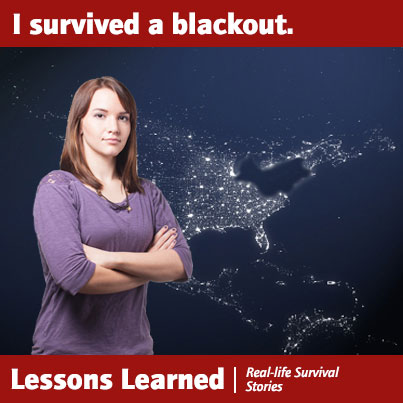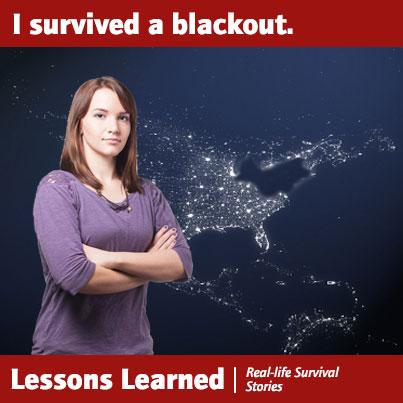This post is part of a series showcasing real-life survival stories. 'Lessons Learned' is a way for individuals and families to share what they learned from living through a disaster. To read all Lessons Learned stories, click here. To submit your own story, click here.

The Northeast Blackout of 2003 affected 45 million people, including my family. The blackout started on August 14. I was 13 at the time, with a 10-year old sister, 3-year old brother, and two older brothers who were 15 and 18. My younger sister had a blast swimming in our neighbor’s pool during this time, but I didn’t dare get in because I didn’t want to be covered in chlorine for days. As a pre-teen girl, the idea of not taking a shower for four days was mortifying. There was one day when it poured rain so hard that I was actually able to get in my bathing suit and take a quick shower in the rain. During the day we felt like we were roasting and wished we had something like a solar generator to power a simple fan. The nights were alright because it gave us a chance to cool off, but scary because everything was pitch black. Fortunately, my mother was prepared ahead of time with emergency candles, 72 hour kits, and a supply of food storage and water. The biggest thing we should have done differently is having moist wipes like the Ready Bath Basics, and a portable toilet. Luckily, our neighbors let us use their pool water to flush our toilet. We wished we had more water because we went through it so quickly. Many food storage products require water to prepare them, which is something we did not consider fully when deciding how much water to store. Natalie HaightThanks Natalie, for sharing your survival story. You did a great job of pointing out essential items to have in an emergency. Luckily Natalie’s family could stay in their home and were able to survive with their emergency kit that included water, food, and lighting. Fellow preppers, storing water should be a priority for you and your family. Here are a couple lessons we gleaned from Natalie's story:
- Store enough to have at least 1 gallon per person per day for 14 days. Store more to make bathing and toilet flushing more than a luxury. Click here to see Emergency Essentials’ water storage options.
- Consider how you might keep your family cool if you’re struggling to survive hot summer weather. You might open all the doors and windows to create ventilation, but do you have netting to keep out insects? Click here to explore various survival scenarios.
- Have a swimming pool.*


3 comments
grama
We & a couple neighbors went to a vacation-ing neighbor’s home to collect pool water—to have on hand to douse small fires from the grills we were using to cook food we didn’t want to spoil. The Aug 15 blackout hours during the day into evening provided a communal picnic atmosphere as refrigs were emptied & refreshments were shared. The heat at night was uncomfortable & after a couple days no one felt safe allowing the kids in the neighbor’s pool water. Having water for fire-emerg was my 1st item. The 2nd was fueling our truck. On Aug 14 I happen to be near a filling station around 4-5p so I gas-d up our big truck but within 1-2 hours people were lining up cars-deep for hours…
thanks for beprepared.com
Lauralee Hensley
I agree with having more than water for drinking, but for preparing food and for everyone to brush teeth and sponge bathe at least. Another thing that would require water is if you needed to cool off, you can hang dampened sheets over an open window if there is some breeze blowing in. It will help to cool down a house a little bit, or you could say that it would only be done in one room of the house and if someone needed to cool off a little bit that they could go into that room that has the dampened sheet hanging over the window. Granted it will have to be re-dampened when it dries out. Also extra water would be needed if you filled up some spray bottles to just mist your skin for evaporative cooling purposes if needed. Also don’t drink things that will make you dehydrate faster, or a lot of sugary drinks that may cause you to possibly be more likely to get a bladder infection, thereby causing you to need to drink more water than normal. Best to stick with water as your main hydrating fluid rather than canned soda pop or kids boxed juices. They are fine in moderation though (maybe one a day, earlier in the day) during periods where they may have to be something to get some fluids into your body by.
Diane R
We have a horse watering trough thst the kids used as a pool. Now they are grown we still fill it and have it for emergencies